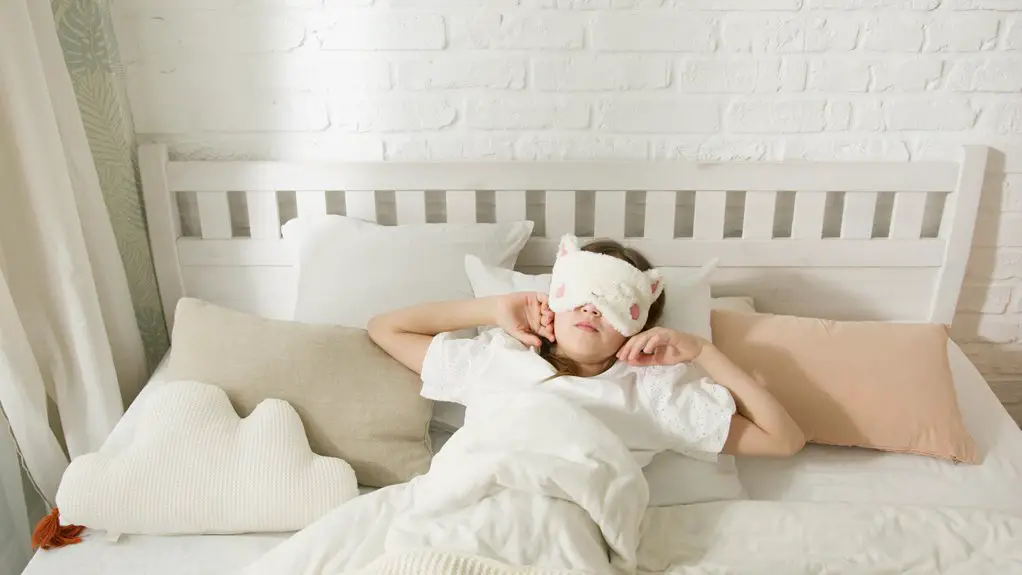Did you know that nearly 80% of children’s sleepwear sold in the U.S. is treated with chemical flame retardants? While these treatments aim to enhance safety, they can pose health risks for your child. Fortunately, there are natural fabric options that provide both comfort and safety. Exploring these alternatives could lead you to a better choice for your little one’s sleepwear. What are the best natural fabrics you should consider?
Table of Contents
Key Takeaways
- Natural fabrics like organic cotton, bamboo, and linen are soft, breathable, and reduce the risk of skin irritations and allergies.
- Cotton and wool are inherently flame-resistant, offering safety without the need for harmful chemical treatments.
- Snug-fitting pajama styles minimize loose fabric that could catch flames, enhancing fire safety for children.
- Choosing natural fabrics helps reduce exposure to harmful chemicals often found in synthetic flame retardants, promoting better health.
- Certifications for safety standards ensure compliance and support informed decisions when selecting children’s sleepwear.
History of Flame Retardant Regulations in Children’s Pajamas
When you look back at the history of flame retardant regulations for children’s pajamas, you’ll find a timeline marked by growing safety awareness.
In the early days, concerns about flammable materials led to the introduction of federal guidelines in the 1970s. These regulations mandated that children’s sleepwear meet specific flammability standards.
As research evolved, so did the understanding of chemical safety. By the late 2000s, studies raised alarms about the potential health risks of certain flame retardants. This prompted further revisions in regulations, pushing manufacturers to seek safer alternatives.
Today, the focus is on balancing effective fire protection with children’s health, leading to ongoing debates about the best materials to use. Your awareness of these changes is essential for making informed choices.
Natural Fabrics: Safety and Breathability
As regulations evolve, many parents are turning to natural fabrics for children’s pajamas, seeking options that prioritize both safety and comfort.
Fabrics like organic cotton, bamboo, and linen are excellent choices. They’re not only soft against your child’s skin but also breathable, helping regulate body temperature during sleep. This breathability is essential, especially for active little ones who tend to get warm at night.
Natural fibers are less likely to irritate sensitive skin, reducing the risk of rashes or allergies. Additionally, they’re often free from harmful chemicals found in some synthetic materials.
The Role of Synthetic Fabrics in Fire Safety
When it comes to fire safety in children’s pajamas, synthetic fabrics play a vital role.
These materials often feature inherent flame resistance, ensuring an added layer of protection.
Plus, many options comply with safety standards without relying on harmful chemicals, giving you peace of mind.
Inherent Flame Resistance
While natural fibers like cotton are popular for children’s pajamas, synthetic fabrics offer an important advantage in fire safety due to their inherent flame resistance.
Fabrics like polyester and nylon have properties that make them less likely to ignite and more resistant to burning. This feature is vital for children’s sleepwear, as it reduces the risk of fire-related accidents.
When you choose pajamas made from these synthetic materials, you’re providing an extra layer of protection for your child. Additionally, synthetic fabrics often retain their flame-resistant qualities even after repeated washing, ensuring ongoing safety.
Chemical-Free Alternatives
Choosing pajamas for your child that prioritize safety doesn’t have to mean sacrificing comfort or style, especially with the availability of chemical-free alternatives.
Natural fibers like organic cotton, bamboo, and linen offer excellent options that are soft and breathable. These materials provide a cozy feel while also reducing the risk of chemical exposure. Unlike synthetic fabrics, which often require chemical treatments for flame resistance, these natural options maintain their safety without harmful additives.
When selecting pajamas, look for those labeled as free from chemical flame retardants.
You’ll find that many brands focus on producing safe, stylish sleepwear that meets your child’s comfort needs while ensuring peace of mind. Your choices can lead to a safer, healthier sleeping environment.
Safety Standards Compliance
Many parents worry about the safety of their children’s sleepwear, especially regarding fire hazards. To guarantee your child’s pajamas are safe, it’s essential to understand safety standards compliance.
Synthetic fabrics often play a key role in fire safety due to their flame-retardant properties. Here are three important points to keep in mind:
- Flame Resistance: Many synthetic fabrics are designed to resist ignition and slow down flame spread, offering an added layer of protection.
- Regulatory Standards: Look for pajamas that comply with safety standards like ASTM F963 and Consumer Product Safety Commission regulations.
- Testing and Certification: Confirm the fabric has been tested for safety and certified by reliable organizations, affirming it meets necessary flame-retardant requirements.
Health Risks Associated With Chemical Flame Retardants
As parents seek safe sleep options for their children, it’s essential to reflect on the potential health risks associated with chemical flame retardants found in pajamas.
Many of these chemicals can release harmful compounds, which may disrupt hormonal balance and impact your child’s development. Studies have linked certain flame retardants to respiratory issues, skin irritations, and even long-term effects like cognitive impairments.
When your child wears pajamas treated with these chemicals, they’re exposed to toxins that could linger in their environment.
It’s vital to evaluate natural alternatives that provide safety without the risk of chemical exposure. Choosing pajamas made from organic cotton or other non-toxic materials can help you protect your child’s health while ensuring they sleep soundly.
Benefits of Snug-Fitting Pajamas
When it comes to children’s pajamas, snug-fitting styles offer enhanced safety features that reduce the risk of fire hazards.
You’ll also find that these pajamas provide improved comfort, allowing your child to move freely while they sleep.
Choosing snug-fit options can give you peace of mind and keep your little one cozy all night long.
Enhanced Safety Features
Snug-fitting pajamas offer enhanced safety features that can considerably reduce the risk of fire-related accidents for children. By minimizing loose fabric, these pajamas help prevent flames from catching and spreading.
Here are three key benefits of snug-fitting pajamas:
- Reduced Flame Exposure: The close fit means less fabric is available to catch fire, lowering the chance of injury.
- Increased Movement Safety: Snug designs help prevent children from tripping or getting tangled while playing or moving around.
- Comfortable Layering: They can be worn under additional clothing or sleep sacks without adding bulk, ensuring a safer sleeping environment.
Choosing snug-fitting pajamas not only enhances safety but also promotes better sleep for your little ones.
Improved Comfort Levels
While safety features play a significant role in the design of children’s pajamas, comfort is equally important for a good night’s sleep. Snug-fitting pajamas offer several benefits that enhance your child’s rest. They help prevent tangling and twisting during sleep, allowing for uninterrupted slumber. The right fabric also wicks moisture, keeping your little one dry and comfortable throughout the night.
Here’s a quick comparison of benefits:
| Benefit | Snug-Fitting Pajamas | Loose Pajamas |
|---|---|---|
| Motion Restriction | Minimal | High |
| Moisture Management | Excellent | Poor |
| Safety | Higher | Lower |
| Temperature Control | Better | Less Effective |
| Sleep Disruption | Reduced | Increased |
Choosing snug-fitting pajamas guarantees your child sleeps soundly and safely.
Popular Natural Fabric Choices for Kids’ Sleepwear
Choosing the right fabric for children’s sleepwear is essential for comfort and safety.
Natural fabrics not only feel great against your child’s skin, but they also provide breathability and softness. Here are three popular choices you might consider:
Natural fabrics offer comfort, breathability, and softness for your child’s sleepwear, ensuring a cozy night’s rest.
- Cotton: This lightweight fabric is soft, breathable, and hypoallergenic, making it ideal for sensitive skin.
- Bamboo: Known for its moisture-wicking properties, bamboo fabric is incredibly soft and has natural antibacterial qualities, keeping your child fresh.
- Linen: This fabric’s natural fibers are breathable and absorb moisture well, making it perfect for warm nights.
Meeting Safety Standards Without Chemicals
When it comes to children’s sleepwear, ensuring safety goes hand in hand with comfort. You want to choose fabrics that meet safety standards without relying on harmful chemicals.
Look for natural fibers like cotton, wool, or hemp, which are inherently flame-resistant due to their molecular structure. These materials provide a cozy feel while also offering protection.
Additionally, many manufacturers are now creating specially treated fabrics that maintain safety without using synthetic flame retardants. By opting for these options, you can rest easy knowing your kids are wearing pajamas that prioritize their safety and well-being.
Always check for certifications that confirm compliance with safety standards. With the right choices, you can achieve both safety and comfort for your little ones.
Trends in Children’s Sleepwear Safety
As parents become more aware of safety concerns, trends in children’s sleepwear are evolving to prioritize not just comfort but also protection.
You’ll notice a strong shift towards materials that are inherently flame-resistant, reducing the need for chemical treatments.
Here are three key trends to keep an eye on:
- Natural Fabrics: Cotton and bamboo are gaining popularity, offering soft, breathable options that meet safety standards without harmful chemicals.
- Eco-friendly Practices: Brands are increasingly adopting sustainable manufacturing processes, ensuring that sleepwear isn’t only safe but also environmentally friendly.
- Enhanced Fit: More companies are focusing on snug-fitting designs, which not only provide comfort but also lower the risk of fabric catching fire.
These trends help you make informed choices for your child’s safety during sleep.
Frequently Asked Questions
Are All Cotton Pajamas Safe for My Child?
Not all cotton pajamas are safe for your child. While cotton’s breathable, you’ll want to check for flame-retardant treatments. Always choose pajamas labeled as compliant with safety standards to guarantee your child’s protection while sleeping.
How Can I Identify Snug-Fitting Pajamas?
To identify snug-fitting pajamas, look for sizes labeled as “fitted” or “snug.” Check the fabric’s stretchiness, ensuring it hugs your child’s body without being too tight. Always consult sizing charts for the best fit.
What Are the Best Brands for Safe Children’S Pajamas?
When searching for safe children’s pajamas, think of a wise owl guiding you. Brands like Hanna Andersson, Carter’s, and Burt’s Bees offer comfort and safety, ensuring your little ones sleep soundly in snug, secure attire.
Can I Wash Flame-Retardant Pajamas Without Losing Effectiveness?
Yes, you can wash flame-retardant pajamas, but you should follow care instructions carefully. Excessive washing or harsh detergents might reduce their effectiveness over time, so using gentle cycles and mild detergents is best.
Are There Specific Age Recommendations for Snug-Fitting Pajamas?
When choosing snug-fitting pajamas, it’s best to take into account your child’s age. For infants and toddlers, snug fits are recommended to reduce fire risk, while older kids might prefer looser styles for comfort and ease of movement.
- Tetron Fabric for Marine Applications: Durability and Use Cases - June 18, 2025
- Tetron Fabric for Outdoor Furniture: Weather Resistance and Care - June 18, 2025
- Tetron Fabric for Wall Coverings: Style and Application Tips - June 18, 2025







